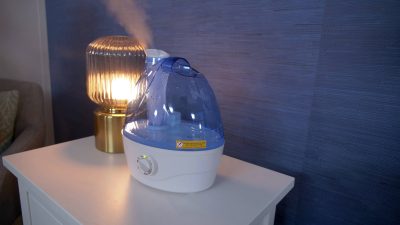
Humidifiers are commonly recommended for use in the winter or when someone is sick — maybe you have memories of a parent pulling one out to use in your childhood bedroom. But how exactly do they work? What is their purpose? Is it worth buying one?
Don’t fret, because I’ll go over all of that and more in this guide to help you determine if a humidifier is right for you, and if so, how to choose the best one.
How Humidity Affects Us During Sleep
In order to understand the purpose of a humidifier and what benefits they can provide, let’s first take a closer look at humidity and how it can affect you during sleep. Humidity is how much moisture is in the air. Humidity levels naturally vary, depending on location and the seasons.
Some environments are naturally more humid than others. Consider the humidity levels in a rainforest versus in a desert — a rainforest naturally has much more moisture. As the weather changes throughout the seasons, the relative humidity in our homes can also shift. Relative humidity — the amount of water vapor currently in the air as a percentage of how much moisture the air could hold if it were saturated — decreases when the temperature of air is increased, such as when central heating blows hot air into your home.
If you’ve ever traveled between a humid and an arid climate, you’ve likely noticed the differences in how you feel, such as your skin being drier, your sweat evaporating more quickly, or your hair being less frizzy in the drier environment.
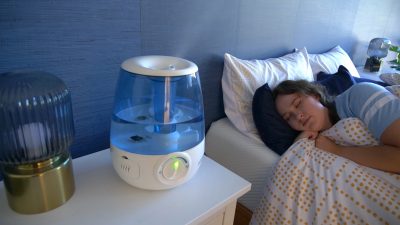
When it comes to your sleep environment, it’s also important to ensure a proper humidity level. Sleeping in a room with low humidity can lead to your skin and mucous membranes (such as the lining of your nose, mouth, lungs, and stomach) to dry out. That can then result in dry skin, an irritated nose and throat, itchy eyes, or chapped lips. Dried-out mucous membranes in your nose can even lead to nosebleeds.
If you have asthma, allergies, or a respiratory infection, a dried-out throat and nasal passages can be especially frustrating, as it can worsen the symptoms of those conditions.
A humidifier can come to your rescue against dry air by increasing the amount of moisture in your bedroom air, preventing your skin and mucous membranes from ever drying out in the first place.
However, it is important not to swing too far in the other direction and over-humidify your bedroom. Too-high humidity can make your bedroom feel stuffy, cause dripping and condensation on your walls, and lead to growth of bacteria, dust mites, and mold — none of which is beneficial for respiratory problems.
If your bedroom is too humid, consider a dehumidifier to reduce the amount of moisture in the air.
How Humidifiers Work
So how exactly do humidifiers work? There are a few different types of humidifiers which use different mechanisms, but all humidifiers are designed to increase the level of moisture by forcing water vapor mist into the air. Let’s go over three of the most common types: evaporative, ultrasonic, and warm mist.
Evaporative Humidifiers
Evaporative humidifiers are a type of cool mist humidifier, meaning the mist emitted from the humidifier is room temperature to cool. They work by speeding up the process of natural evaporation. They use a fan to blow air through a damp filter, which causes the water to evaporate into water vapor. That water vapor is then blown or otherwise emitted into the room to increase the humidity level. This type of humidifier is a good way to ensure the mist blowing into your room is clean, but also requires replacing the filter periodically.
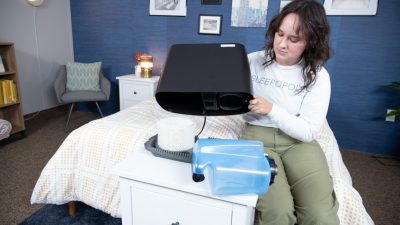
For an example of an evaporative humidifier, take a look at our Honeywell Cool Moisture humidifier review.
Ultrasonic Humidifiers
Ultrasonic humidifiers are also a type of cool mist humidifier. They use high-frequency sound vibrations or a nebulizer to break the water into droplets, which are then propelled into the air with a fan or other mechanism. These humidifiers generally do not require a filter and can operate more quietly than evaporative humidifiers.
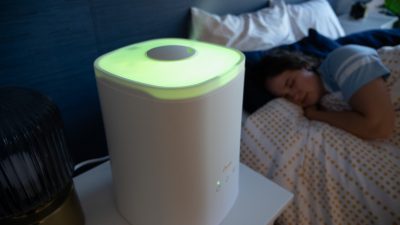
For an example of an ultrasonic humidifier, take a look at our Crane Top Fill Ultrasonic Cool Mist humidifier review.
Warm Mist Humidifiers
Warm mist humidifiers differ from evaporative and ultrasonic humidifiers because they produce (as the name suggests) a warm mist in the form of steam. Warm mist humidifiers boil the water, changing it from a liquid to a gas. This allows the warm mist to permeate the air and increase the humidity. Warm mist can work more quickly to humidify the room, can warm up your room, and has the added bonus of the water boiling — and thus purifying — before it is emitted.
However, there are some safety concerns regarding boiling water. If you have pets, kids, or have a tendency to knock things over, a humidifier full of boiling water might not be the best choice.
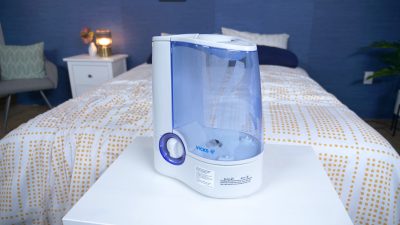
For an example of a warm mist humidifier, take a look at our Vicks Warm Mist humidifier review.
Humidifier Shopping Tips
With a solid grasp of different types of humidifiers and how they work under your belt, let’s go over some tips on what to look out for as you shop for your own humidifier.
- Decide which type of humidifier you want. Each style has its own pros and cons, so evaluate what type of mist you would prefer, how much maintenance you can reasonably carry out, and your price range.
- Consider whether your sleep is easily disturbed by light or noise. Some humidifiers have nightlight features — some can be turned on or off, but some turn on automatically. This could disrupt some people’s sleep. Similarly, some humidifiers are noisier than others. This is harder to determine without testing the humidifier yourself, but humidifiers with fans may be louder than other styles. Check reviews to see if others found the humidifier noisy or quiet.
- Think about size and style. First, you should pick a humidifier that is designed for the size of your room, as humidifiers vary in their output. Some cover 200 square feet; others can cover 500 square feet. You should also consider the size of the humidifier itself and ensure it will fit comfortably on a level surface in your bedroom. Additionally, your humidifier will be visible in your bedroom, so you may want to pick a style that blends with your decor.
- Research required maintenance. Even among humidifiers of the same style, each product can require different maintenance. For example, some humidifiers include pieces that can be washed in a dishwasher. Others must be entirely cleaned by hand. Also, humidifiers with filters will require periodic replacement, which is an added cost.
- Decide if you want additional features. Some humidifiers double as a diffuser or an air purifier. If you are interested in two similar products, you might be able to find one product that does both.
Final Thoughts
Humidifiers can be a great help in the winter or in dry environments. Hopefully after reading this article, you have a better understanding of how humidifiers work, the different types, and what to look for when shopping for a humidifier. Be sure to check out our favorite picks on our best humidifiers roundup.
Keep in mind that humidifiers aren’t a cure-all — if you’re looking to purchase a humidifier to help with a specific condition, we recommend consulting your doctor or a medical professional first to be sure you are addressing the problem properly.
Happy humidifying!



























